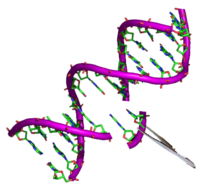
Photo from wikipedia
Pediatric acute myeloid leukemia (AML) with the translocation t(7;12)(q36;p13) is a form of childhood leukemia associated with inferior outcome. In the current investigation we have studied the gene alterations that… Click to show full abstract
Pediatric acute myeloid leukemia (AML) with the translocation t(7;12)(q36;p13) is a form of childhood leukemia associated with inferior outcome. In the current investigation we have studied the gene alterations that are induced by this chromosomal translocation, a gene fusion MNX1-ETV6 but also ectopic expression of the homeobox gene MNX1. In a murine bone marrow transplantation model, our results showed that ectopic expression of MNX1 was able to induce AML, but not the MNX1-ETV6 gene fusion. However, this transformation to AML was only seen using hematopoietic progenitor cells from fetal liver and not adult bone marrow cells. This was accompanied with an alteration of cell differentiation towards myeloid lineage, increased proliferation and colony formation capacity induced by MNX1. Our data also showed that ectopic expression of MNX1, and to a lower extend MNX1-ETV6 fusion, induced DNA damage and cell cycle arrest, where we saw an increased expression and binding of the MNX1 and the MNX1-ETV6 fusion to the gene CEP164 that has a critical role in cell cycle regulation and DNA damage response, and the transcriptional pioneer factor gene PBX1 that is important in development and differentiation. Furthermore, global histone modifications, specifically H3K4me3 and H3K27me, were induced by MNX1 but also the MNX1-ETV6 fusion. We could also see an enrichment of methylation/methionine proteins from mass spectrometry analysis of proteins associated with MNX1. In conclusion, these results suggest a possible mechanism by which MNX1 mediates its transforming effect through abnormal methylation of proteins that result in changed histone modifications and subsequent dysregulation of gene expression. Our finding that only fetal liver cells were able to transform into AML is also in concordance with the clinical finding that this AML subtype is only found in very young children.
Journal Title: Experimental Hematology
Year Published: 2020
Link to full text (if available)
Share on Social Media: Sign Up to like & get
recommendations!